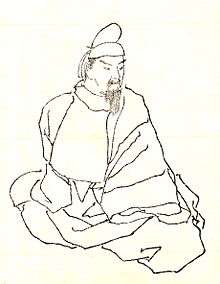Fujiwara no Momokawa
| Fujiwara no Momokawa | |
|---|---|
 | |
| Born | 732 |
| Died | 28 August 779 (aged 46–47) |
| Heir | Fujiwara no Otsugu |
| Spouse(s) | Fujiwara no Moroane |
| Parents |
Fujiwara no Umakai (father) Kume no Wakame (mother) |
Fujiwara no Momokawa (藤原 百川, 732 - August 28, 779) was a Japanese statesman, courtier and politician during the Nara period.[1] His original name was Odamaro (雄田麻呂).
Career at court
He was a minister during the reigns of Empress Kōken/Shōtoku and Emperor Kōnin.[1]
- 770 (Jingo-keiun 4, 8th month): When Empress Shōtoku died without having named an heir, Momokawa was influential in the process which led to the enthronement of Emperor Kōnin.[2]
- 773 (Hōki 4): Sangi Momokawa was chief advocate for Daigaku-no-kami Yamabe-shinnō,[3] who was named Crown Prince and heir of Kōnin.[4]
- August 28, 779 (Hōki 10, 7th month): Momkawa died at age 48.[5]
The posthumous influence of Momokawa was ensured when Emperor Kammu followed Emperor Kōnin on the Chrysanthemum Throne.[6]
Genealogy
Momokawa's father was Fujiwara no Umakai;[1] and his mother was Kume no Wakame. He was one of eight brothers (including Fujiwara no Hirotsugu).
Momokawa married Fujiwara no Moroane, daughter of Fujiwara no Yoshitsugu, a noble during the Nara period. His children included two sons: Fujiwara no Otsugu (774-843),[7] Fujiwara no Tsugunari (779-842). His daughters were Fujiwara no Tabiko (759-788), and Fujiwara no Tarashiko (?-794).
Tabiko became the consort of Emperor Kammu with whom she bore Prince Ōtomo,[8] who became Emperor Junna).[9] During Emperor Junna's reign, she was the Empress Dowager.
Tarashiko was the wife of Emperor Heizei. She died in 794 during the moving of the imperial capital to Heian-kyō. In 806, she received the posthumous title of kōgō when Emperor Heizei was enthroned.[10]
Notes
- 1 2 3 Nussbaum, Louis-Frédéric. (2005). "Fujiwara no Momokawa" in Japan Encyclopedia, p. 206, p. 206, at Google Books.
- ↑ Titsingh, Isaac. (1834). Annales des empereurs du japon, p. 81., p. 81, at Google Books.
- ↑ Ponsonby-Fane, Richard. (1959). The Imperial Family, pp. 60-61.
- ↑ Titsingh, pp. 82-83., p. 82, at Google Books; Ponsonby-Fane, p. 317.
- ↑ Titsingh, p. 84., p. 84, at Google Books
- ↑ Titsingh, pp. 83-84., p. 83, at Google Books
- ↑ Titsingh, pp. 88., p. 88, at Google Books
- ↑ Titsingh, p. 88., p. 88, at Google Books.
- ↑ Titsingh, p. 103., p. 103, at Google Books.
- ↑ Ponsonby-Fane, p. 318.
References
- Kanō, Shigefumi. "Fujiwara no Momokawa" in Jōshidai Kokubun (『女子大国文』) (volume 111, 1992)
- Kimoto, Yoshinobu. "Fujiwara no Momokawa" in Fujiwara Shikike Kanjin no Kōsatsu (『藤原式家官人の考察』) (Takashina Shoten, 1998)
- Nussbaum, Louis-Frédéric and Käthe Roth. (2005). Japan encyclopedia. Cambridge: Harvard University Press. ISBN 978-0-674-01753-5; OCLC 58053128
- Ponsonby-Fane, Richard Arthur Brabazon. (1959). The Imperial House of Japan. Kyoto: Ponsonby Memorial Society. OCLC 194887
- Takinami, Sadako. "Fujiwara no Nagate and Fujiwara no Momokawa" (「藤原永手と藤原百川」 Fujiwara no Nagate to Fujiwara no Momokawa) in Research on Court Society in Ancient Japan (『日本古代宮廷社会の研究』 Nihon Kodai Kyūtei Shakai no Kenkyū) (Shibunkaku, November 1991, ISBN 4-7842-0677-9)
- Titsingh, Isaac. (1834). Annales des empereurs du Japon (Nihon Odai Ichiran). Paris: Royal Asiatic Society, Oriental Translation Fund of Great Britain and Ireland. OCLC 5850691